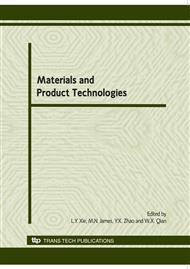p.65
p.70
p.75
p.80
p.90
p.95
p.100
p.105
p.111
Mechanical and Physical Characters of the Cast Steel for Chinese Railway Rolling Wagon Bogie Frames
Abstract:
Chemical composition, metallurgical photos, macro- and micro-hardness values, macrostructures, inclusions, denseness, mechanical properties are experimentally investigated on the grade B cast steel for the bogie frames of Chinese railway rolling wagons. Results reveal that the material consists of ferrites and pearlites. Micro-hardness values of the ferrites are significant lower those of pearlites to indicate the ferrites is the weakest phase of material. Casting flaws are mainly point-network like eutectic sulfur compounds and polygonal sphere like Al2S3 compounds. Lower Young's modulus, higher proportion of yielding to ultimate strengths, higher reduction of area, and a lower elongation than those of conventional ferrous alloys are exhibited. These characters are contributed to the non-sharp cast flaws. The flaws play roles of two effects. One is to benefit anti-vibration capacity and fracture roughness. And another is to decrease the mechanical strengths.
Info:
Periodical:
Pages:
90-94
Citation:
Online since:
June 2010
Authors:
Keywords:
Price:
Сopyright:
© 2010 Trans Tech Publications Ltd. All Rights Reserved
Share:
Citation:


